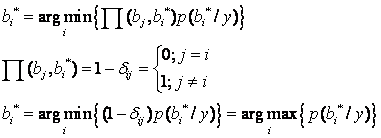
средний квадрат ошибки системы. Если ввести в рассмотрение систему управления, построенную по принципу систем с обратной связью как показано на рисунке 2.4, где Fη –некоторое случайное возмущающее
воздействие, то ошибка управления может быть представлена как G B H
Рисунок 2.4
Так какFη – случайный процесс, то выходная переменная y(t), а следовательно и ошибка δ(t), будут также случайными процессами. Поэтому ошибку δ(t) характеризуют в статистическом плане. Наиболее простой статистической характеристикой является средний квадрат ошибки, который связан с дисперсией Iδ и мат. ожиданием Jδ следующим соотношением:
KL6B H 8 M I N JN
Таким образом, средний квадрат ошибки учитывает, как случайную составляющую ошибки ( Iδ ), так и систематическую (среднюю — Jδ ).
Действительно несложно показать, что
Iδ МL6δ Jδ8 M МOδ 2δJδ Jδ P МOδ P 2МLδMJδ
|
Jδ МOδ P Jδ , откуда |
М{δ }=Iδ Jδ . |
|
Положительный корень |
квадратный из среднего квадрата ошибки |
называется средней квадратичной ошибкой. Средняя квадратичная ошибка 16

имеет размерность выходного сигнала системы и поэтому при практических расчётах является более удобной характеристикой, чем средний квадрат ошибки. Критерий минимума средней квадратичной ошибки получил широкое распространение в практике проектирования систем управления электромеханическими объектами благодаря тому, что он прост в математическом отношении и для многих практических задач является удовлетворительной мерой успешности решения поставленной задачи управления:
η QIδ Jδ
Для астатических систем управления постоянная составляющая
ошибки управления равна нулю Jδ 0 . В этом случае
критерий минимума средней квадратичной ошибки получит вид:
η bIδ
Практика проектирования электромеханических систем управления показывает, что стремление минимизировать значение функционала η часто приводит к решению, которое не обеспечивает системе требуемого запаса устойчивости. Чтобы ограничить колебательность систем в этом случае, при решении задач на параметрическую оптимизацию, в качестве критерия качества целесообразно рассматривать составной критерий вида:
в котором c и c -весовые коэффициенты, регулирующие вклад каждой составляющей функционала качества в его значение.
2.2 Организация вычисления составного критерия качества в процессе
параметрической оптимизации систем управления.
17
Ранее уже отмечалось, что критерий оптимальности должен быть сформирован таким образом, чтобы с одной стороны служить мерой качества управления, а с другой стороны его значение можно было сравнительно просто вычислить.
Применительно к виду критерия (2-15) рассмотрим возможную организацию его вычисления. С этой целью введём в рассмотрение структурную схему рисунок 2.5, где обозначено:
−W0 (p),Wр ( p) − передаточные функции неизменяемой части системы
(объекта управления) и регулятора, за счёт варьирования параметров
которого должен быть обеспечен экстремум критерия качества;
−Wф (p) − передаточная функция фильтра, который формирует из случайного процесса ψ (t) типа «белого шума» возмущающее воздействие Mη (t) с заданной спектральной характеристикой;
|
− |
t Т |
− |
текущее время с начала процесса моделирования; |
|||
|
− |
t1 |
− |
время окончания отработки системой ступенчатого управления |
|||
|
u(t) = uо и |
подачи |
на её вход |
синусоидального управляющего |
|||
|
воздействия uв (t) = Um sin(ωэt) , а на объект управления возмущающего |
||||||
|
воздействия Mη (t); |
||||||
|
− |
t2 |
− |
момент |
начала |
вычисления |
части Jη составного критерия |
качества;
−T0 − период дискретизации изучаемого процесса δ(t) , где δ(t) — текущее значение ошибки слежения за изменением управляющего воздействия.
18
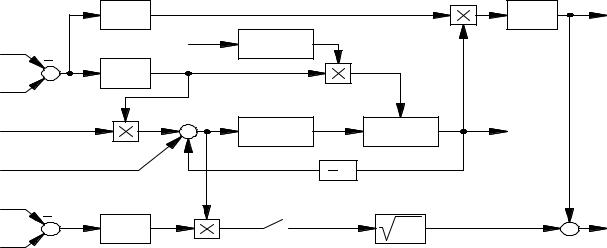
|
z |
2 |
F |
J 2 |
|||||
|
U (t) |
U (t) |
|||||||
|
WФ |
( p) |
|||||||
|
z |
||||||||
|
1 |
||||||||
|
δ (t) W |
( p) |
W |
( p ) |
y(t) |
||||
|
Р |
Н |
|||||||
|
1 |
||||||||
|
z3 |
δ (nTД |
) |
Sδ2 |
J |
1 |
J |
||
|
TД |
||||||||
|
Рисунок 2.5 |
Введенные в структурную схему функции f1 , f2 , f3 следующим образом определяют текущие значения переменных zi :
|
z1 = |
f1 (t1 |
,tT ) = |
tT |
≤ t1; |
||
|
0, |
||||||
|
1, |
tT |
> t1 . |
||||
|
z2 = |
f2 (t1 |
,tT ) = |
tT |
≤ t1; |
||
|
1, |
||||||
|
0, |
tT |
> t1 . |
||||
|
z3 = |
f3 (t2 |
,tT ) = |
tT |
≤ t2 ; |
||
|
0, |
||||||
|
1, |
tT |
> t2 . |
||||
Организация процесса моделирования проектируемой системы для вычисления функционала качества J на i-ом шаге движения к экстремуму (минимуму) поясняет рисунок 2.6, на котором обозначено: yM , yУ — максимальное и установившееся значения выходной переменной на интервале 0 ≤ tT < t1 . Весь процесс моделирования условно может быть разделен на 2 этапа.
На первом этапе ( 0 ≤ tT < t1 ) на вход системы подается ступенчатое управляющее воздействие u0 (t) и определяется значение
|
J2 |
= F(y,α,m) = |
α ≤ 45% |
& m ≤ 5; |
||
|
0, |
|||||
|
1000, |
α > 45% |
|| m > 5, |
|||
19
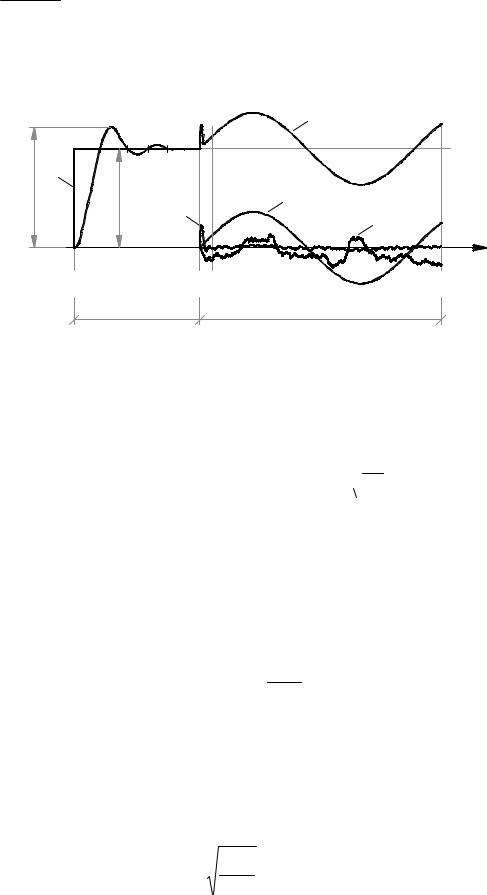
|
где α = yM − yУ 100% — величина перерегулирования, а m – число переходов |
||||||
|
yУ |
||||||
|
кривой переходного процесса выходной переменной y через установившееся |
||||||
|
значение при отработке системой ступенчатого управления. |
||||||
|
y(t) |
||||||
|
m = 1 |
2 |
3 |
4 |
|||
|
yM |
u0 (t) |
|||||
|
y |
δ(t) |
uB (t) |
||||
|
У |
U (t) |
|||||
|
tT |
||||||
|
0 |
t1 t2 |
tK |
||||
|
1 этап |
2 этап |
Рисунок 2.6
На втором этапе (t1 < tT ≤ tK ) на вход системы подается эквивалентное гармоническое воздействие, а на объект управления – возмущение Uµ (t) с заданной спектральной характеристикой. Начиная с момента t2 , вычисляется оценка средней квадратической ошибки наведения 
Время tB = tK − t2 , необходимое для вычисления оценки дисперсии ошибки наведения Sδ2 , может быть определено из следующих соображений.
Известно, что дисперсия оценки дисперсии может быть представлена в виде [1]:
Var[Sδ2 ] = 2σδ4 ,
n −1
где σδ2 — истинное значение дисперсии ошибки, а n – число наблюдений. Зададимся вероятностью того, что интервальная оценка дисперсии должна накрывать ее истинное значение величиной равной Р=0.95, что соответствует 2σ -пределу. Тогда можно записать
22σδ4 = ∆n , n −1
20

где ∆n — ширина интервала, который с вероятностью Р=0.95 будет накрывать истинное значение дисперсии.
Если ∆n принять равной, например, 10% от истинного значения, то
|
∆n |
= |
∆n |
|||||||||||||
|
есть положить |
= 0.1 , тогда |
2 2 |
= 0.1 , |
откуда |
требуемое |
||||||||||
|
σ 2 |
n −1 |
σ 2 |
|||||||||||||
|
количество наблюдений |
|||||||||||||||
|
2 |
|||||||||||||||
|
2 2 |
|||||||||||||||
|
n = |
+1 ≈ 800. |
||||||||||||||
|
0.1 |
|||||||||||||||
|
Теперь для |
определения значения tB |
необходимо |
оценить |
величину |
периода дискретизации TД изучаемого процесса. Обычно это может быть сделано на основании анализа характеристик внешних воздействий, приложенных к системе. Например, если в результате такого анализа принято
|
решение, что детализация наблюдений с частотами выше |
f =10Гц не будет |
|||||||
|
приводить к повышению информативности изучаемого |
процесса, тогда |
|||||||
|
T |
1 |
= 0.05c , а, следовательно, t |
=T |
n = 0.05 800 = 40c. |
||||
|
Д |
B |
Д |
||||||
|
2 f |
||||||||
21
Соседние файлы в папке Лекции
- #
- #
- #
- #
- #
Критерий — минимум — среднеквадратичная ошибка
Cтраница 1
Критерий минимума среднеквадратичной ошибки используется для решения более сложных задач по сравнению с задачей определения оптимальных параметров при известной структуре системы.
[1]
Идея приближения по критерию минимума среднеквадратичной ошибки, как уже указывалось, не единственна.
[2]
Тх корректирующего устройства по критерию минимума среднеквадратичной ошибки, если полезный сигнал и помеха независимы и приложены к одной точке системы.
[3]
Первое из этих условий удовлетворялось и при синтезе по критерию минимума среднеквадратичной ошибки.
[4]
Адекватность полученной модели и необходимость ее коррекции оценивают чаще всего по критерию минимума среднеквадратичной ошибки. Этот метод наиболее целесообразен.
[5]
Причем объем вычислений может быть значительно уменьшен за счет незначительного ухудшения качества, фильтрации по критерию минимума среднеквадратичной ошибки.
[6]
В большинстве практически встречающихся случаев представляется возможным, хотя бы в первом приближении, рассматривать процессы изменения технологических величин или других производственных показателей как стационарные случайные функции с нормальным распределением. Поэтому обычно критерий минимума среднеквадратичной ошибки является наиболее приемлемым в качестве критерия наилучшего предсказания в большинстве рассматриваемых задач управления.
[7]
Кроме того, по критерию минимума среднеквадратичной ошибки определяются оптимальная структура и передаточная функция замкнутой системы, обеспечивающие минимальную величину погрешности.
[8]
Анализ и синтез нелинейных систем с неизвестной структурой предлагается проводить с помощью многопеременных прямоугольных функций. Практически реализуемый алгоритм с применением этих функций получен на основе критерия минимума среднеквадратичной ошибки. Алгоритм применим при входных стационарных сигналах с произвольной плотностью распределения вероятностей.
[9]
Задача заключается в оценке значений, к-рые реализация рассматриваемого процесса ( или нек-рых его параметров, таких, как ср. Здесь в большинстве случаев определяется инвариантный во времени линейный реализуемый фильтр, оптимизирующий оценку по критерию минимума среднеквадратичной ошибки. Возможны и часто желательны др. критерии, но указанный критерий отличается математич. Для решения задач такого рода часто применяется теория Винера — Колмогорова. В этой теории предполагается, что сигнал S ( t) характеризуется только статистич. Мешающий шум N ( t) представляет также чисто случайный процесс, комбинируется с сигналом аддитивно и может быть с ним связан статистически. Далее предполагается, что накопление и обработка данных совершаются только над прошлым процессов на входе, к-рые считаются стационарными в широком смысле и имеющими положительно определенные ковариант-ные ф-ции. Кроме того, в большинстве случаев реализуются оптимальные линейные фильтры, к-рые не только реализуемы, но также и инвариантны во времени. При этих условиях импульсная переходная ф-ция линейного фильтра определяется из интегр.
[10]
Задача заключается в оценке значений, к-рые реализация рассматриваемого процесса ( или нек-рых его параметров, таких, как ср. Здесь в большинство случаев определяется инвариантный во времени линейный реализуемый фильтр, оптимизирующий оценку по критерию минимума среднеквадратичной ошибки. Возможны и часто желательны др. критерии, но указанный критерий отличается математич. Для решения задач такого рода часто применяется теория Винера — Колмогорова. В этой теории предполагается, что сигнал S ( t) характеризуется только статпстич. Мешающий шум N ( t) представляет также чисто случайный процесс, комбинируется с сигналом аддитивно и может быть с ним связан статистически. Далее предполагается, что накопление и обработка данных совершаются только над прошлым процессов па входе, к-рые считаются стационарными в широком смысле и имеющими положительно определенные ковариант-ные ф-ции. Кроме того, в большинстве случаев реализуются оптимальные линейные фильтры, к-рые не только реализуемы, но также и инвариантны во времени. При этих условиях импульсная переходная ф-ция линейного фильтра определяется из интегр.
[11]
После определения среднеквадратичной ошибки необходимо обеспечить минимальное значение ее. Наиболее просто задача решается путем минимизации среднеквадратичной ошибки по тому или иному параметру системы при заданных воздействиях. В качестве параметров, которые желательно сделать оптимальными на основе критерия минимума среднеквадратичной ошибки, могут рассматриваться различные постоянные, имеющие большое значение для определения динамических свойств системы.
[12]
Страницы:
1
Анализ систем на основе критерия минимума среднеквадратичной ошибки [c.189]
Если ковариационные функции процессов Х( ) и У(/) известны точно, то можно воспользоваться винеровским критерием минимума среднеквадратичной ошибки Этот критерий утверждает, что функция /г(и) должна быть выбрана так, чтобы минимизировать среднеквадратичную ошибку шумовой компоненты, т е [c.190]
Синтез следящих систем. Одно из первых инженерных применений анализа на основе критерия минимума среднеквадратичной ошибки было сделано при синтезировании следящих систем для зенитных орудий и в радиолокационных следящих системах [5] Например, от радиолокационной следящей системы требуется, чтобы она следила за самолетом несмотря на возмущения отра- [c.189]
Другое применение критерий минимума среднеквадратичной ошибки находит в задаче об идентификации системы В этом случае в распоряжении имеются входной сигнал и соответствующий ему выходной сигнал от некоторой системы, требуется вывести линейное приближение к этой системе для дальнейшего его использования при управлении или моделировании Предположим, например, что система представляет собой черный ящик (рис 5 7). Если вход является реализацией случайного процесса Х 1), то выход можно рассматривать как реализацию случайного процесса У(0< где [c.190]
Оптимальное в любом смысле корреляционное окно, например (7 2 3), будет зависеть от неизвестного спектра Гхх(/). Этот недостаток свойствен не только спектральному анализу Вообще говоря, справедливо правило, согласно которому наилучший план действий должен опираться на некоторые представления об истинном положении вещей Следовательно, очень валено проводить четкое различие между планированием спектрального анализа до сбора данных и самим анализом данных, после того как они собраны Мы хотели бы использовать критерии минимума среднеквадратичной ошибки или какой-нибудь аналогичный критерий до проведения спектрального анализа, чтобы решить, например, какой длины нужно взять запись Но после того как данные собраны, могло бы оказаться, что наши представления относительно Гхх (/) были абсолютно неправильны [c.26]
Если плотность вероятности ге ([х у) симметрична относительно среднего значения гпг [х у и унимодальна (т. е. монотонно невозрастающая функция [х — /П] [х у ), то байесовская оценка (5.18) совпадает с оценкой по критерию максимума апостериорной плотности вероятности. В этом случае функция С (х) не должна быть обязательно выпуклой, а лишь монотонно неубывающей функцией х (см. приложение С). Так как нормальная плотность вероятности унимодальна, то всегда, когда плотность вероятности ге ([х I у) нормальна, оценка по максимуму апостериорной плотности вероятности совпадает с широким классом байесовских оценок, который включает оценки по минимуму среднеквадратичной ошибки (или минимуму дисперсии). [c.158]
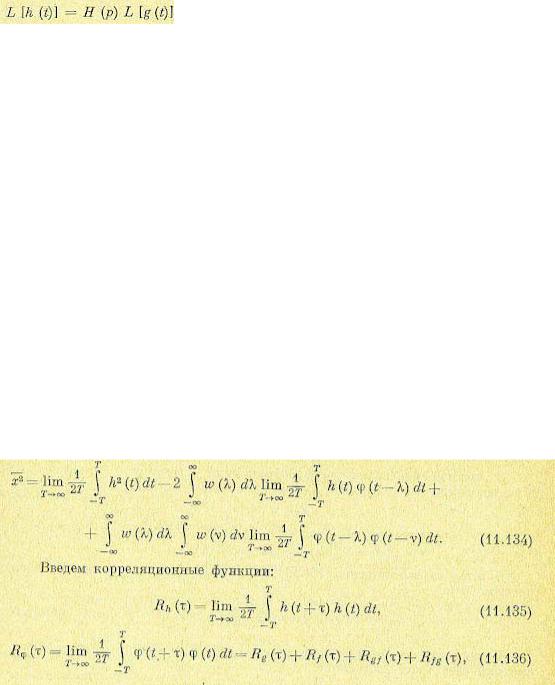
достаточно простом выражении для дисперсии это может быть определено непосредственным дифференцированием и приравниванием нулю частных производных.
В более сложных случаях приходится искать минимум дисперсии путем числового задания интересующих параметров и построения соответствующих графиков.
Другая постановка задачи при расчете по критерию минимума среднеквадратичной ошибки заключается в том, что ставится вопрос о нахождении оптимальной структуры и значений параметров автоматической системы, при которых обеспечивается получение теоретического минимума среднеквадратичной ошибки при заданных вероятностных характеристиках полезного сигнала и помехи. Эта задача будет решена, если найти, например, передаточную функцию
замкнутой системы 
Задача относится к категории вариационных задач. Приведем здесь некоторые результаты ее решения [120] для случая, когда полезный сигнал g (t) и помеха f (I) представляют собой центрированные стационарные случайные процессы, приложенные на входе системы. Перед системой ставится задача преобразовывать входной сигнал g (t) так, чтобы на ее выходе воспроизводилась величина h (t), связанная с g (t) некоторой формулой преобразования
тде Н (р) — преобразующий оператор.
Так, например, при 
сглаживанием помехи (обычная следящая система при наличии помех), при 
На основании изложенного ошибку системы можно представить в виде

Выходная величина системы регулирования

где 

Задача заключается в том, чтобы найти частотную передаточную функцию замкнутой системы, связанную с весовой функцией преобразованием Фурье

таким образом, чтобы минимизировать значение 
Раскроем в выражении (11.132) скобки и изменим порядок интегрирования:
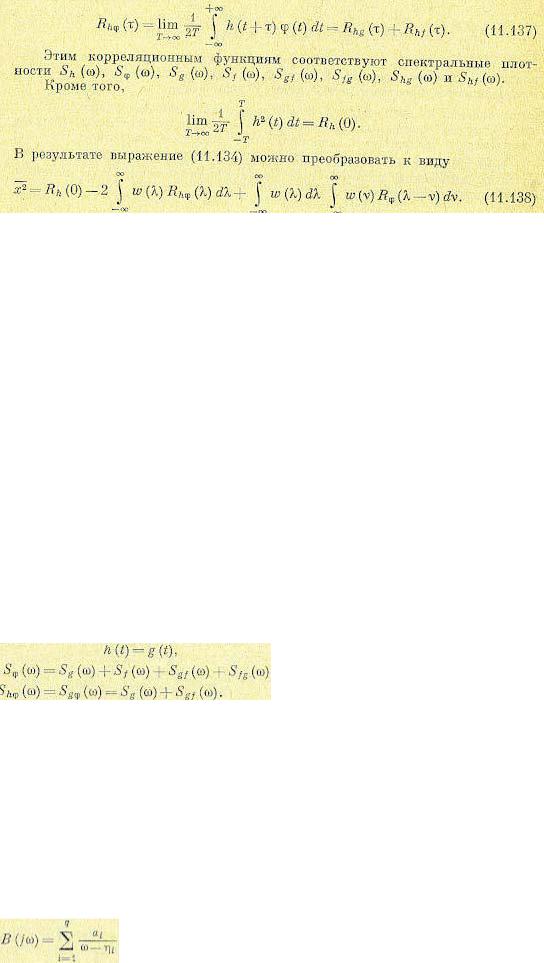
Так как в реальных системах 

Из последнего выражения видно, что оптимальная весовая функция, соответствующая минимуму среднего квадрата ошибки, определяется только видом корреляционных функций полезного сигнала и помехи.
Можно показать [120], что необходимое и достаточное условие минимизации выражения (11.139), которое должно быть наложено на весовую функцию, заключается в том, чтобы она была решением интегрального уравнения Винера — Хопфа

Оптимальная передаточная функция (11.133), соответствующая оптимальной весовой функции, являющейся решением уравнения (11.140), может быть представлена в виде

где

Вчастном случае, когда преобразующий оператор Н(р) = 1, т. е в так называемом случае оптимального сглаживания, имеем
Вэтом случае решение (11.141) может быть представлено в более простом виде:

Числитель этого выражения определяется следующим образом. Рассмотрим следующее выражение:

Здесь 




(11.145)

При реализации в системе оптимальной передаточной функции получится теоретический минимум среднего квадрата ошибки. Этот минимум определяется выражением или, в другом виде,

или, в другом виде,

Рассмотрим иллюстративный пример. Предположим, что полезному сигналу и помехе на входе системы регулирования соответствуют спектральные плотности:
причем корреляция между ними отсутствует и 
Отсюда знаменатель искомой передаточной функции (11.143)
Отбросив первый член в скобках, соответствующий полюсу в нижней полуплоскости, находим числитель искомой передаточной функции (11.143):
Нахождение оптимальной передаточной функции еще не означает, что реальная автоматическая система может быть выполнена оптимальной, так как реализация ее может быть сопряжена с большими трудностями. Оптимальную передаточную функцию, за исключением простейших случаев, следует считать идеальной функцией, к которой по возможности надо стремиться при выполнении реальной автоматической системы. Теория оптимальных систем излагается в работах [26, 108, 120, 121].
ГЛАВА 12. МЕТОДЫ СИНТЕЗА СИСТЕМ АВТОМАТИЧЕСКОГО РЕГУЛИРОВАНИЯ
§ 12.1. Общие соображения
Под синтезом системы автоматического регулирования понимается направленный расчет, имеющий конечной целью отыскание рациональной структуры системы и установление оптимальных величин параметров ее отдельных звеньев. По отношению к основе синтеза в настоящее время имеются разные точки зрения.
Синтез можно трактовать как пример вариационной задачи и рассматривать такое построение системы автоматического регулирования, при котором для данных условий работы (управляющие и возмущающие воздействия, помехи, ограничения по времени работы и т. п.) обеспечивается теоретический минимум ошибки.
Синтез также можно трактовать как инженерную задачу, сводящуюся к такому построению системы автоматического регулирования, при котором обеспечивается выполнение технических требований к ней. Подразумевается, что из.многих возможных решений Инженер, проектирующий систему, будет выбирать те, которые являются оптимальными с точки зрения существующих конкретных условий и требований к габаритам, весу, простоте, надежности и т. п.
Иногда в понятие инженерного синтеза вкладывается еще более узкий смысл и рассматривается синтез, имеющий целью определение вида и параметров корректирующих средств, которые необходимо добавить к некоторой неизменяемой части системы регулирования (объект с регулятором), чтобы обеспечить требуемые динамические качества.
При инженерном синтезе системы автоматического регулирования необходимо обеспечить, во-первых, требуемую точность и, во-вторых, приемлемый характер переходных процессов.
Решение первой задачи в большинстве случаев сводится к определению требуемого общего коэффициента усиления системы и, в случае необходимости,— вида корректирующих средств, повышающих точность системы (регулирование по управляющему и возмущающему воздействиям, изодром-ные механизмы и т. п.). Эта задача может решаться при помощи определения ошибок в типовых режимах на основе тех критериев точности, которые были изложены в главе 8. Решение этой задачи, как правило, не сопряжено с трудностями принципиального или вычислительного характера, так как критерии точности достаточно просты для их практического использования. В сложных случаях можно прибегать к помощи моделирования. Решение оказывается сравнительно простым вследствие необходимости установления значений относительно небольшого числа параметров. В простейшем случае необходимо найти только общий коэффициент усиления системы.
Решение второй задачи — обеспечение приемлемых переходных процессов — оказывается почти всегда более трудным вследствие большого числа варьируемых параметров и многозначности решения задачи демпфирования системы. Поэтому существующие инженерные методы часто ограничиваются решением только второй задачи, так как их авторы считают, что обеспечение требуемой точности может быть достаточно просто сделано на основании использования существующих критериев точности и совершенствования их практически не требуется.
В настоящее время для целей синтеза систем автоматического регулирования широко используются электронные и электромеханические вычислительные машины, позволяющие производить полное или частичное моделирование проектируемой системы. При таком моделировании становится возможным наиболее полно исследовать влияние различных факторов нелинейности, зависимость параметров от времени и т. п.
Однако моделирование на вычислительных машинах не может заменить расчетных методов проектирования, которые во многих случаях позволяют исследовать вопрос в общем виде и среди многих решений найти оптимальное. Поэтому, несмотря на развитие и распространение машинных методов синтеза, теория должна располагать собственными методами, которые дополняли бы моделирование и являлись бы теоретической базой при отыскании оптимального решения.

§ 12.2. Корневой метод
Наиболее простой корневой метод разработан Т. Н. Соколовым [117]. Сущность его сводится к следующему. [В соответствии с изложенным в § 12.1 рассматривается только задача
.получения приемлемых динамических качеств при заданном значении общего коэффициента усиления, т. е. последнего члена характеристического уравнения.]
Пусть имеется характеристическое уравнение системы

С точки зрения скорейшего затухания переходного процесса важно, чтобы вещественные части всех корней характеристического уравнения были наибольшими. Сумма вещественных частей всех корней численно равна первому коэффициенту характеристического уравнения (12.1). Поэтому при заданной величине этого коэффициента наивыгоднейшие результаты получаются при равенстве вещественных частей всех корней/ Однако расчеты и исследования построенных систем показывают, что стремление удовлетворить поставленному требованию приводит к совершенно нереальным конструктивным характеристикам отдельных звеньев. Эти расчеты и исследования показывают, что из общего числа корней характеристического уравнения всегда можно выделить два или три корня с меньшей по абсолютному значению вещественной частью, которые и определяют ход основного процесса. Остальные же корни характеризуют быстро затухающие составляющие, оказывающие влияние только на начальной стадии переходного процесса.
Примем, что основной характер переходного процесса определяется двумя корнями. Тогда уравнение (12.1) удобно представить в виде
(12.2)
Второй сомножитель (12.2) и будет определять основной характер процесса.
Для уменьшения погрешностей проектируемой системы важно, чтобы коэффициент В2 в основном множителе имел возможно большую величину. Однако чрезмерное увеличение В2 приводит к колебательному характеру переходного процесса.
Оптимальное соотношение между коэффициентами B1 и В2 определяется из условия получения затухания за один период 

где 
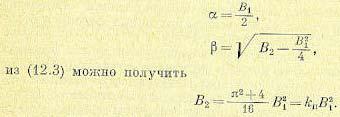
Множитель 
Из (12.3) можно также получить требуемое соотношение между мнимой и вещественной частями корня (колебательность):

В ряде случаев для описания основного переходного процесса оказывается более целесообразным воспользоваться уравнением третьей степени
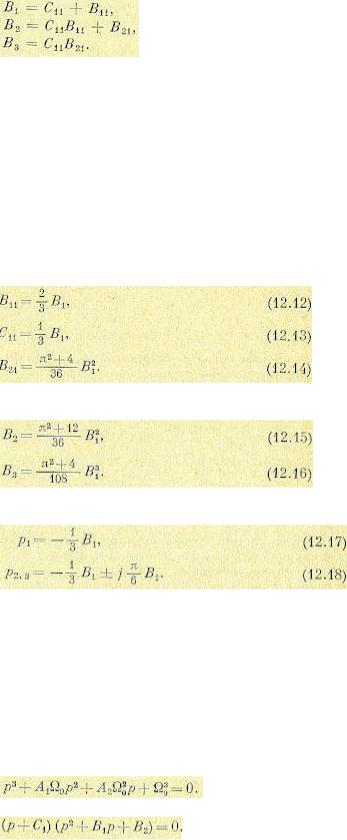

Это уравнение можно представить в виде

Между коэффициентами уравнений (12.6) и (12.7) имеют место соотношения:
Положим, что во втором множителе (12.7) по-прежнему

Поэтому корни характеристического уравнения (12.6) и (12.7) равны: 

Так как вещественная часть корней должна быть возможно большей, то целесообразно задать

и, следовательно,
Подставив полученные значения в формулы разложения, находим зависимость между коэффициентами основного уравнения. Если В1 задано, то
Эти соотношения должны реализоваться при проектировании системы регулирования. Корни основного уравнения
Выбор уравнения для описания основной составляющей переходного процесса зависит от структурной схемы проектируемой системы.
Рассмотрим теперь связь между основной и дополнительной составляющими переходного процесса для заданного затухания ξ (8.40). Для этой цели полезно представить характеристическое уравнение (12.1) в таком виде:

где 
Записанное в такой форме уравнение третьей степени принимает вид
Разлагая его на множители, находим
Соотношения для коэффициентов:

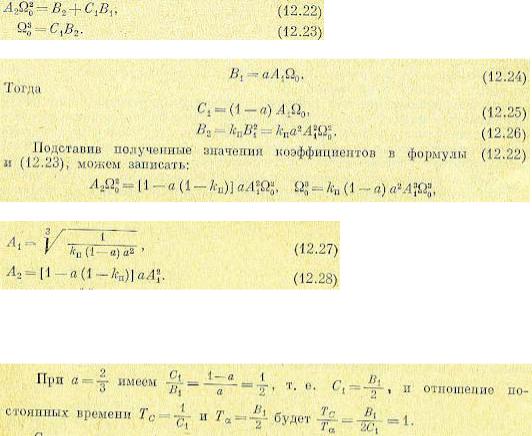
Введем коэффициент а и положим
откуда
Таким образом, безразмерные коэффициенты А1 и A2 являются функциями критерия переходного процесса &ш зависящего от. желаемой степени затухания и коэффициента разложения а, определяющего соотношение постоянных времени затухания отдельных составляющих.
Следовательно, обе составляющие переходного процесса затухают с одинаковой скоростью. Аналогичным образом можно получить выражения для коэффициентов
характеристического уравнения четвертой, пятой и более высоких степеней [117].
Синтез системы регулирования начинается с того, что для выбранной структурной схемы и введенных корректирующих средств находится характеристическое уравнение. Затем варьируются параметры основного канала регулирования и корректирующих средств таким образом, чтобы получить требуемые значения коэффициентов характеристического уравнения
(12.1) или (12.20).
Этот метод оказывается достаточно эффективным в случае сравнительно невысокой степени характеристического уравнения (n=2-4). В более сложных случаях обеспечить требуемые значения коэффициентов характеристического уравнения оказывается затруднительно, так как некоторые параметры системы и корректирующих средств могут влиять сразу на несколько коэффициентов характеристического уравнения.
Недостатком этого метода является также то, что необходимо задаваться видом корректирующих средств. Поэтому получаемое решение будет во многом зависеть от опытности проектанта.
§ 12.3. Метод корневых годографов
Качество системы регулирования с точки зрения быстродействия и запаса устойчивости может характеризоваться расположением корней числителя и знаменателя передаточной функции замкнутой системы, т. е. расположением нулей и полюсов передаточной функции (§ 8.6).
Зная эти корни, можно изобразить их расположение на комплексной плоскости корней. При расчете регулируемой системы целесообразно проследить, как меняется общая картина расположения корней при изменении отдельных параметров, например общего коэффициента усиления, постоянных времени корректирующих цепей и т. п., с целью установления оптимальных значений этих параметров.
При плавном изменении значения какого-либо параметра корни будут перемещаться на плоскости корней, прочерчивая некоторую кривую, которую будем называть корневым

годографом или траекторией корней. Построив траектории всех корней, можно выбрать такое значение варьируемого параметра, которое соответствует наилучшему расположению корней.
Первый способ построения траекторий корней заключается в следующем. Пусть имеется дифференциальное уравнение замкнутой системы, записанное для регулируемой величины при наличии задающего воздействия (5.3):
Это уравнение записано здесь для случая равенства нулю возмущающих воздействий. Оно может быть записано также для любого возмущающего-воздействия. Это не изменит его формы и не отразится на дальнейших рассуждениях.
Передаточная функция замкнутой системы

Полюсы передаточной функции, т. е. корни знаменателя, обозначим через 
ее нули (корни числителя) —через 
Коэффициенты числителя и знаменателя (12.29) определенным образом выражены через параметры регулируемого объекта, регулятора и корректирующих устройств. Если нужно
выбрать величину какого-либо параметра 
значения для всех остальных параметров, а для искомого параметра 
числовые значения 
Если нужно выбрать два или несколько параметров регулируемой системы, то такого рода вычисления нужно проделать несколько раз, меняя каждый раз один из параметров при заданных значениях всех остальных.
Вычисление корней при этом можно производить любым численным методом, возможно более простым, так как ввиду приближенности корневой оценки здесь не требуется большой точности вычислений. В настоящее время имеются электрические устройства, позволяющие строить на экране траектории корней непосредственно по заданным коэффициентам уравнения.
Из простых численных методов определения корней можно рекомендовать, например, метод последовательных делений [98].
Другой способ построения траекторий корней, разработанный Ивэнсом и Э. Г. Удерманом [128], в отличие от первого, пригодного для выбора любого параметра системы, специально приспособлен для выбора общего коэффициента усиления передаточной функции разомкнутой системы (5.10), которую запишем следующим образом:

Здесь К = Кr — общий коэффициент усиления разомкнутой системы, имеющий размерность сек-r, где r — степень астатизма; G1 (р) — операторная часть передаточной функции разомкнутой системы.
Характеристическое уравнение системы может быть записано в виде

Обозначим полюсы и нули передаточной функции разомкнутой системы соответственно через 
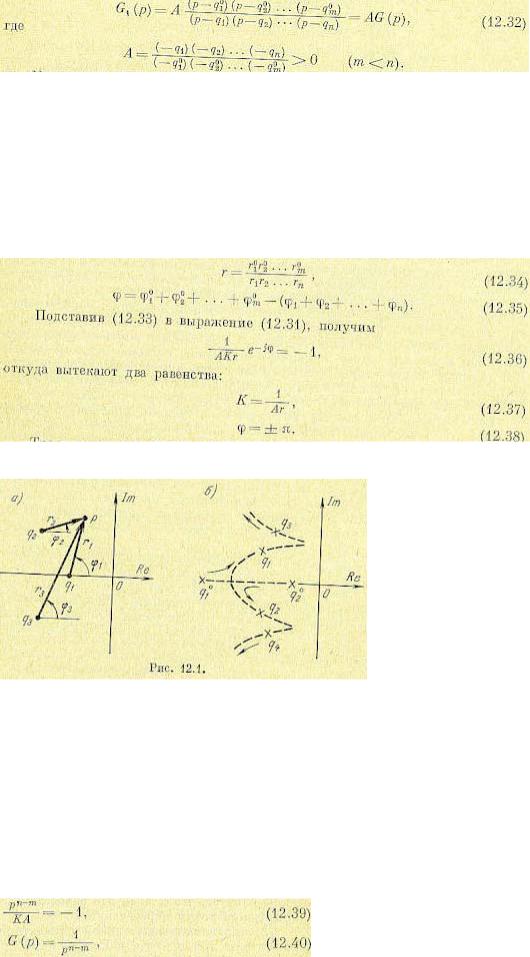
Каждый сомножитель в выражении (12.32) можно изобразить в виде вектора на комплексной плоскости (рис. 12.1), где р — текущая точка. Обозначим длину (модуль) каждого
вектора в знаменателе (12.32) через 

(аргумент) для знаменателя обозначим 


где
Траектории корней (рис. 12.1) строятся таким образом, чтобы они удовлетворяли условию (12.38). После этого по формуле (12.34) для каждой
конкретной комбинации корней можно вычислить А и величину r, а затем по формуле (12.37) — общий коэффициент усиления К.
Для упрощения построения траекторий корней используются следующие свойства. 1.При К = 0 корни характеристического уравнения замкнутой системы совпадают с
полюсами передаточной функции разомкнутой системы W (р) или G (р), так как согласно (12.31) при К = 0 имеем 
2. При 
как при 




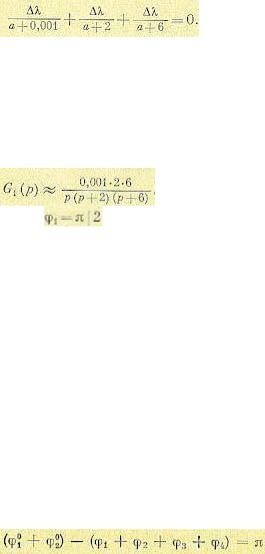
откуда аргумент комплексного числа 


3.На вещественной оси траектории корней представляют собой отрезки прямой, соединяющие нули и полюсы функции G (р), расположенные на этой оси. Началом траекторий на вещественной оси служит нуль, расположенный правее всех остальных.
4.Если траектория отклоняется от вещественной оси, то положение точки р = а, в которой траектория отходит от этой оси, можно оценить из того условия, что при малом отклонении 
Так, например, пусть имеется функция

При К = 0 траектории исходят из точек (—0,001), (—2) и (—6), лежащих на вещественной
оси. Отрезки траекторий лежат между точками (—0,001) ж (—2) и между (—6) и 
Решение этого квадратного уравнения дает 
5. Положение точки, в которой траектория пересекает мнимую ось при переходе в правую полуплоскость комплексной переменной р, часто можно оценить, пренебрегая влиянием малого по абсолютной величине полюса функции G (р).
Рассмотрим в качестве примера опять функцию (12.42). При значительных по модулю величинах комплексной переменной р эту функцию можно с хорошей точностью аппроксимировать функцией
Тогда (рис. 12.2) и, следовательно, условие (12.38) сводится к равенству




6. Направление касательной к траектории при выходе ее из какого-либо полюса или при подходе к какому-либо нулю нетрудно определить путем вычисления угла между этой касательной в данном полюсе или нуле и вещественной осью. При таком вычислении используется зависимость (12.38) для аргументов всех нулей и полюсов, расположенных по условию в левой полуплоскости комплексной переменной р.
На рис. 12.3 изображены траектории корней передаточной функции G (р), имеющей два нуля и два полюса на вещественной оси и одну пару комплексных сопряженных полюсов. При
достаточно малом удалении точки р от полюса q4 углы 
остальным нулям и полюсам, останутся неизменными. Таким образом, в силу (12.38) угол 
From Wikipedia, the free encyclopedia
In statistics, the mean squared error (MSE)[1] or mean squared deviation (MSD) of an estimator (of a procedure for estimating an unobserved quantity) measures the average of the squares of the errors—that is, the average squared difference between the estimated values and the actual value. MSE is a risk function, corresponding to the expected value of the squared error loss.[2] The fact that MSE is almost always strictly positive (and not zero) is because of randomness or because the estimator does not account for information that could produce a more accurate estimate.[3] In machine learning, specifically empirical risk minimization, MSE may refer to the empirical risk (the average loss on an observed data set), as an estimate of the true MSE (the true risk: the average loss on the actual population distribution).
The MSE is a measure of the quality of an estimator. As it is derived from the square of Euclidean distance, it is always a positive value that decreases as the error approaches zero.
The MSE is the second moment (about the origin) of the error, and thus incorporates both the variance of the estimator (how widely spread the estimates are from one data sample to another) and its bias (how far off the average estimated value is from the true value).[citation needed] For an unbiased estimator, the MSE is the variance of the estimator. Like the variance, MSE has the same units of measurement as the square of the quantity being estimated. In an analogy to standard deviation, taking the square root of MSE yields the root-mean-square error or root-mean-square deviation (RMSE or RMSD), which has the same units as the quantity being estimated; for an unbiased estimator, the RMSE is the square root of the variance, known as the standard error.
Definition and basic properties[edit]
The MSE either assesses the quality of a predictor (i.e., a function mapping arbitrary inputs to a sample of values of some random variable), or of an estimator (i.e., a mathematical function mapping a sample of data to an estimate of a parameter of the population from which the data is sampled). The definition of an MSE differs according to whether one is describing a predictor or an estimator.
Predictor[edit]
If a vector of 



In other words, the MSE is the mean 

In matrix notation,
where 



The MSE can also be computed on q data points that were not used in estimating the model, either because they were held back for this purpose, or because these data have been newly obtained. Within this process, known as statistical learning, the MSE is often called the test MSE,[4] and is computed as
Estimator[edit]
The MSE of an estimator 

This definition depends on the unknown parameter, but the MSE is a priori a property of an estimator. The MSE could be a function of unknown parameters, in which case any estimator of the MSE based on estimates of these parameters would be a function of the data (and thus a random variable). If the estimator 
The MSE can be written as the sum of the variance of the estimator and the squared bias of the estimator, providing a useful way to calculate the MSE and implying that in the case of unbiased estimators, the MSE and variance are equivalent.[5]
Proof of variance and bias relationship[edit]
An even shorter proof can be achieved using the well-known formula that for a random variable 



But in real modeling case, MSE could be described as the addition of model variance, model bias, and irreducible uncertainty (see Bias–variance tradeoff). According to the relationship, the MSE of the estimators could be simply used for the efficiency comparison, which includes the information of estimator variance and bias. This is called MSE criterion.
In regression[edit]
In regression analysis, plotting is a more natural way to view the overall trend of the whole data. The mean of the distance from each point to the predicted regression model can be calculated, and shown as the mean squared error. The squaring is critical to reduce the complexity with negative signs. To minimize MSE, the model could be more accurate, which would mean the model is closer to actual data. One example of a linear regression using this method is the least squares method—which evaluates appropriateness of linear regression model to model bivariate dataset,[6] but whose limitation is related to known distribution of the data.
The term mean squared error is sometimes used to refer to the unbiased estimate of error variance: the residual sum of squares divided by the number of degrees of freedom. This definition for a known, computed quantity differs from the above definition for the computed MSE of a predictor, in that a different denominator is used. The denominator is the sample size reduced by the number of model parameters estimated from the same data, (n−p) for p regressors or (n−p−1) if an intercept is used (see errors and residuals in statistics for more details).[7] Although the MSE (as defined in this article) is not an unbiased estimator of the error variance, it is consistent, given the consistency of the predictor.
In regression analysis, «mean squared error», often referred to as mean squared prediction error or «out-of-sample mean squared error», can also refer to the mean value of the squared deviations of the predictions from the true values, over an out-of-sample test space, generated by a model estimated over a particular sample space. This also is a known, computed quantity, and it varies by sample and by out-of-sample test space.
Examples[edit]
Mean[edit]
Suppose we have a random sample of size 




which has an expected value equal to the true mean 
where 
For a Gaussian distribution, this is the best unbiased estimator (i.e., one with the lowest MSE among all unbiased estimators), but not, say, for a uniform distribution.
Variance[edit]
The usual estimator for the variance is the corrected sample variance:
This is unbiased (its expected value is 
where 

However, one can use other estimators for 

then we calculate:
This is minimized when
For a Gaussian distribution, where 



Further, while the corrected sample variance is the best unbiased estimator (minimum mean squared error among unbiased estimators) of variance for Gaussian distributions, if the distribution is not Gaussian, then even among unbiased estimators, the best unbiased estimator of the variance may not be 
Gaussian distribution[edit]
The following table gives several estimators of the true parameters of the population, μ and σ2, for the Gaussian case.[9]
| True value | Estimator | Mean squared error |
|---|---|---|
 |
 = the unbiased estimator of the population mean, = the unbiased estimator of the population mean,  |

|
 |
 = the unbiased estimator of the population variance, = the unbiased estimator of the population variance,  |

|
 |
 = the biased estimator of the population variance, = the biased estimator of the population variance,  |

|
 |
 = the biased estimator of the population variance, = the biased estimator of the population variance,  |

|
Interpretation[edit]
An MSE of zero, meaning that the estimator 

Values of MSE may be used for comparative purposes. Two or more statistical models may be compared using their MSEs—as a measure of how well they explain a given set of observations: An unbiased estimator (estimated from a statistical model) with the smallest variance among all unbiased estimators is the best unbiased estimator or MVUE (Minimum-Variance Unbiased Estimator).
Both analysis of variance and linear regression techniques estimate the MSE as part of the analysis and use the estimated MSE to determine the statistical significance of the factors or predictors under study. The goal of experimental design is to construct experiments in such a way that when the observations are analyzed, the MSE is close to zero relative to the magnitude of at least one of the estimated treatment effects.
In one-way analysis of variance, MSE can be calculated by the division of the sum of squared errors and the degree of freedom. Also, the f-value is the ratio of the mean squared treatment and the MSE.
MSE is also used in several stepwise regression techniques as part of the determination as to how many predictors from a candidate set to include in a model for a given set of observations.
Applications[edit]
- Minimizing MSE is a key criterion in selecting estimators: see minimum mean-square error. Among unbiased estimators, minimizing the MSE is equivalent to minimizing the variance, and the estimator that does this is the minimum variance unbiased estimator. However, a biased estimator may have lower MSE; see estimator bias.
- In statistical modelling the MSE can represent the difference between the actual observations and the observation values predicted by the model. In this context, it is used to determine the extent to which the model fits the data as well as whether removing some explanatory variables is possible without significantly harming the model’s predictive ability.
- In forecasting and prediction, the Brier score is a measure of forecast skill based on MSE.
Loss function[edit]
Squared error loss is one of the most widely used loss functions in statistics[citation needed], though its widespread use stems more from mathematical convenience than considerations of actual loss in applications. Carl Friedrich Gauss, who introduced the use of mean squared error, was aware of its arbitrariness and was in agreement with objections to it on these grounds.[3] The mathematical benefits of mean squared error are particularly evident in its use at analyzing the performance of linear regression, as it allows one to partition the variation in a dataset into variation explained by the model and variation explained by randomness.
Criticism[edit]
The use of mean squared error without question has been criticized by the decision theorist James Berger. Mean squared error is the negative of the expected value of one specific utility function, the quadratic utility function, which may not be the appropriate utility function to use under a given set of circumstances. There are, however, some scenarios where mean squared error can serve as a good approximation to a loss function occurring naturally in an application.[10]
Like variance, mean squared error has the disadvantage of heavily weighting outliers.[11] This is a result of the squaring of each term, which effectively weights large errors more heavily than small ones. This property, undesirable in many applications, has led researchers to use alternatives such as the mean absolute error, or those based on the median.
See also[edit]
- Bias–variance tradeoff
- Hodges’ estimator
- James–Stein estimator
- Mean percentage error
- Mean square quantization error
- Mean square weighted deviation
- Mean squared displacement
- Mean squared prediction error
- Minimum mean square error
- Minimum mean squared error estimator
- Overfitting
- Peak signal-to-noise ratio
Notes[edit]
- ^ This can be proved by Jensen’s inequality as follows. The fourth central moment is an upper bound for the square of variance, so that the least value for their ratio is one, therefore, the least value for the excess kurtosis is −2, achieved, for instance, by a Bernoulli with p=1/2.
References[edit]
- ^ a b «Mean Squared Error (MSE)». www.probabilitycourse.com. Retrieved 2020-09-12.
- ^ Bickel, Peter J.; Doksum, Kjell A. (2015). Mathematical Statistics: Basic Ideas and Selected Topics. Vol. I (Second ed.). p. 20.
If we use quadratic loss, our risk function is called the mean squared error (MSE) …
- ^ a b Lehmann, E. L.; Casella, George (1998). Theory of Point Estimation (2nd ed.). New York: Springer. ISBN 978-0-387-98502-2. MR 1639875.
- ^ Gareth, James; Witten, Daniela; Hastie, Trevor; Tibshirani, Rob (2021). An Introduction to Statistical Learning: with Applications in R. Springer. ISBN 978-1071614174.
- ^ Wackerly, Dennis; Mendenhall, William; Scheaffer, Richard L. (2008). Mathematical Statistics with Applications (7 ed.). Belmont, CA, USA: Thomson Higher Education. ISBN 978-0-495-38508-0.
- ^ A modern introduction to probability and statistics : understanding why and how. Dekking, Michel, 1946-. London: Springer. 2005. ISBN 978-1-85233-896-1. OCLC 262680588.
{{cite book}}: CS1 maint: others (link) - ^ Steel, R.G.D, and Torrie, J. H., Principles and Procedures of Statistics with Special Reference to the Biological Sciences., McGraw Hill, 1960, page 288.
- ^ Mood, A.; Graybill, F.; Boes, D. (1974). Introduction to the Theory of Statistics (3rd ed.). McGraw-Hill. p. 229.
- ^ DeGroot, Morris H. (1980). Probability and Statistics (2nd ed.). Addison-Wesley.
- ^ Berger, James O. (1985). «2.4.2 Certain Standard Loss Functions». Statistical Decision Theory and Bayesian Analysis (2nd ed.). New York: Springer-Verlag. p. 60. ISBN 978-0-387-96098-2. MR 0804611.
- ^ Bermejo, Sergio; Cabestany, Joan (2001). «Oriented principal component analysis for large margin classifiers». Neural Networks. 14 (10): 1447–1461. doi:10.1016/S0893-6080(01)00106-X. PMID 11771723.
Применим закон распределения равновероятности:
(4)
Подставляя (1) и (2) и (4) и вводя обозначения с фазой
Последовательная схема может быть
также реализована на основе СФ.
Нормальные
и аномальные ошибки.
Необходимо рассматривать
,
тогда
если ,
либо соответствует
, то
Эта же задача стоит при
радиоизмерениях. И она может решаться при построении оптимального устройства, с
различными критериями.
Статистические
критерии оценки непрерывных параметров
сигнала.
Cуществуют
следующие критерии:
ü
Критерий максимума функции правдоподобия.
ü
максимальная апостериорная плотность распределения вероятности
параметра .
ü
Критерий минимума средне квадратичной ошибки.
ü
Критерий Баеса.
Распишем каждый критерий более
подробно.
Критерий максимального
правдоподобия.

максимального правдоподобия.
Критерий максимальной
апостериорной вероятности.
Рассмотрим статистическую схему:
Оценивается значение
максимального параметра.
Критерий минимальной средне
квадратичной ошибки.
Ошибки, связанные с фиксацией , не выходящие за пределы
корреляционного пика называются нормальные ошибки (инстр. ошибки,
ошибки шума).
Шумовая составляющая:
Дисперсия:
Шумовая составляющая имеет вид , но её особенность, что
количество сигнальных выбросов тем больше, чем больше шумовой уровень.
При регистрации шумовой выброс
может быть принят за сигнальный выброс. Ошибка может составить , а нормальные ошибки не выходят за
корреляционные пределы. Вероятность появления аномальных ошибок характеризует
неправильность измерения вообще.
При проектировании задают
соотношение сигнал/шум, чтобы избежать аномальных ошибок.
А среднеквадратичная ошибка
параметра .
Расчёт среднеквадратической ошибки.
Рассмотрим формулу исходя из
геометрического происхождения сигнала.
In statistics and signal processing, a minimum mean square error (MMSE) estimator is an estimation method which minimizes the mean square error (MSE), which is a common measure of estimator quality, of the fitted values of a dependent variable. In the Bayesian setting, the term MMSE more specifically refers to estimation with quadratic loss function. In such case, the MMSE estimator is given by the posterior mean of the parameter to be estimated. Since the posterior mean is cumbersome to calculate, the form of the MMSE estimator is usually constrained to be within a certain class of functions. Linear MMSE estimators are a popular choice since they are easy to use, easy to calculate, and very versatile. It has given rise to many popular estimators such as the Wiener–Kolmogorov filter and Kalman filter.
Motivation[edit]
The term MMSE more specifically refers to estimation in a Bayesian setting with quadratic cost function. The basic idea behind the Bayesian approach to estimation stems from practical situations where we often have some prior information about the parameter to be estimated. For instance, we may have prior information about the range that the parameter can assume; or we may have an old estimate of the parameter that we want to modify when a new observation is made available; or the statistics of an actual random signal such as speech. This is in contrast to the non-Bayesian approach like minimum-variance unbiased estimator (MVUE) where absolutely nothing is assumed to be known about the parameter in advance and which does not account for such situations. In the Bayesian approach, such prior information is captured by the prior probability density function of the parameters; and based directly on Bayes theorem, it allows us to make better posterior estimates as more observations become available. Thus unlike non-Bayesian approach where parameters of interest are assumed to be deterministic, but unknown constants, the Bayesian estimator seeks to estimate a parameter that is itself a random variable. Furthermore, Bayesian estimation can also deal with situations where the sequence of observations are not necessarily independent. Thus Bayesian estimation provides yet another alternative to the MVUE. This is useful when the MVUE does not exist or cannot be found.
Definition[edit]
Let 







where the expectation 




The MMSE estimator is then defined as the estimator achieving minimal MSE:
Properties[edit]
- When the means and variances are finite, the MMSE estimator is uniquely defined[1] and is given by:
-
- In other words, the MMSE estimator is the conditional expectation of
given the known observed value of the measurements. Also, since
is the posterior mean, the error covariance matrix
is equal to the posterior covariance
matrix,
.
- The MMSE estimator is unbiased (under the regularity assumptions mentioned above):
- The MMSE estimator is asymptotically unbiased and it converges in distribution to the normal distribution:
-
- where
is the Fisher information of
. Thus, the MMSE estimator is asymptotically efficient.
-
- for all
in closed, linear subspace
of the measurements. For random vectors, since the MSE for estimation of a random vector is the sum of the MSEs of the coordinates, finding the MMSE estimator of a random vector decomposes into finding the MMSE estimators of the coordinates of X separately:
- for all i and j. More succinctly put, the cross-correlation between the minimum estimation error
and the estimator
should be zero,
Linear MMSE estimator[edit]
In many cases, it is not possible to determine the analytical expression of the MMSE estimator. Two basic numerical approaches to obtain the MMSE estimate depends on either finding the conditional expectation 
One possibility is to abandon the full optimality requirements and seek a technique minimizing the MSE within a particular class of estimators, such as the class of linear estimators. Thus, we postulate that the conditional expectation of 







One advantage of such linear MMSE estimator is that it is not necessary to explicitly calculate the posterior probability density function of 




The expression for optimal 

where 






Thus, the expression for linear MMSE estimator, its mean, and its auto-covariance is given by
where the 


Lastly, the error covariance and minimum mean square error achievable by such estimator is
Univariate case[edit]
For the special case when both 

where 


The above two equations allows us to interpret the correlation coefficient either as normalized slope of linear regression
or as square root of the ratio of two variances
.
When 








Computation[edit]
Standard method like Gauss elimination can be used to solve the matrix equation for 




Linear MMSE estimator for linear observation process[edit]
Let us further model the underlying process of observation as a linear process: 




Thus the expression for the linear MMSE estimator matrix 
Putting everything into the expression for 
Lastly, the error covariance is
The significant difference between the estimation problem treated above and those of least squares and Gauss–Markov estimate is that the number of observations m, (i.e. the dimension of 






Alternative form[edit]
An alternative form of expression can be obtained by using the matrix identity
which can be established by post-multiplying by 

and
Since 



In this form the above expression can be easily compared with weighed least square and Gauss–Markov estimate. In particular, when 







Sequential linear MMSE estimation[edit]
In many real-time applications, observational data is not available in a single batch. Instead the observations are made in a sequence. One possible approach is to use the sequential observations to update an old estimate as additional data becomes available, leading to finer estimates. One crucial difference between batch estimation and sequential estimation is that sequential estimation requires an additional Markov assumption.
In the Bayesian framework, such recursive estimation is easily facilitated using Bayes’ rule. Given 


The 





This is the Markov assumption.
The MMSE estimate 


Thus, the prior density for k-th time step is the posterior density of (k-1)-th time step. This structure allows us to formulate a recursive approach to estimation.
In the context of linear MMSE estimator, the formula for the estimate will have the same form as before: 




For the prior density 
,
and its covariance matrix is given by the previous error covariance matrix,
as per by the properties of MMSE estimators and the stationarity assumption.
Similarly, for the linear observation process, the mean of the likelihood 

.
The difference between the predicted value of 



![{\displaystyle \mathrm {E} [{\tilde {y}}_{k}]=0}](https://wikimedia.org/api/rest_v1/media/math/render/svg/b7333e06de208be900c7d618273db57bf678fb1f)

Hence, in the estimate update formula, we should replace 








Thus, we have the new estimate as new observation 
and the new error covariance as
From the point of view of linear algebra, for sequential estimation, if we have an estimate 

The repeated use of the above two equations as more observations become available lead to recursive estimation techniques. The expressions can be more compactly written as
The matrix 
The repetition of these three steps as more data becomes available leads to an iterative estimation algorithm. The generalization of this idea to non-stationary cases gives rise to the Kalman filter. The three update steps outlined above indeed form the update step of the Kalman filter.
Special case: scalar observations[edit]
As an important special case, an easy to use recursive expression can be derived when at each k-th time instant the underlying linear observation process yields a scalar such that 





where 

The 
Here, no matrix inversion is required. Also, the gain factor, 



Alternative approaches: This important special case has also given rise to many other iterative methods (or adaptive filters), such as the least mean squares filter and recursive least squares filter, that directly solves the original MSE optimization problem using stochastic gradient descents. However, since the estimation error 


where 

[edit]
In many practical applications, the observation noise is uncorrelated. That is, 



where 












Examples[edit]
Example 1[edit]
We shall take a linear prediction problem as an example. Let a linear combination of observed scalar random variables 



![{\displaystyle z=[z_{1},z_{2},z_{3},z_{4}]^{T}}](https://wikimedia.org/api/rest_v1/media/math/render/svg/45cb1f9123fdf786074088616e42dfbcc1359d07)
then our task is to find the coefficients 

In terms of the terminology developed in the previous sections, for this problem we have the observation vector ![{\displaystyle y=[z_{1},z_{2},z_{3}]^{T}}](https://wikimedia.org/api/rest_v1/media/math/render/svg/7fdeb8eb600c7a066561d28e2b3f32fb5b1572b9)
![W=[w_{1},w_{2},w_{3}]](https://wikimedia.org/api/rest_v1/media/math/render/svg/dd8e9343b228a9044dbb8208e9ceeb31270b04c1)


The cross correlation matrix 
We now solve the equation 

So we have 

as the optimal coefficients for 
mean square error then gives ![{\displaystyle \left\Vert e\right\Vert _{\min }^{2}=\operatorname {E} [z_{4}z_{4}]-WC_{YX}=15-WC_{YX}=.2857}](https://wikimedia.org/api/rest_v1/media/math/render/svg/44558ab7a0b5ead1b9571853096d800773b38877)


Example 2[edit]
Consider a vector 



![1=[1,1,\ldots ,1]^{T}](https://wikimedia.org/api/rest_v1/media/math/render/svg/43fec89f837a5e8d53869fb49ec95a9e56a788f0)

![[-x_{0},x_{0}]](https://wikimedia.org/api/rest_v1/media/math/render/svg/e79873ca5ddfd5d6b0168f6373b33c8bc3756c69)


![[-x_{0},x_{0}]](https://wikimedia.org/api/rest_v1/media/math/render/svg/e79873ca5ddfd5d6b0168f6373b33c8bc3756c69)








Thus, the linear MMSE estimator is given by
We can simplify the expression by using the alternative form for 
where for ![y=[y_{1},y_{2},\ldots ,y_{N}]^{T}](https://wikimedia.org/api/rest_v1/media/math/render/svg/8317c7045e5b1318cec0c4ee89727a02cdeecafc)

Similarly, the variance of the estimator is
Thus the MMSE of this linear estimator is
For very large 
while the variance will be unaffected by data 
However, the estimator is suboptimal since it is constrained to be linear. Had the random variable 

Example 3[edit]
Consider a variation of the above example: Two candidates are standing for an election. Let the fraction of votes that a candidate will receive on an election day be ![x\in [0,1].](https://wikimedia.org/api/rest_v1/media/math/render/svg/1c44eb6b4643a03d3c166df0e61c4925b6d4d4f0)


![[0,1]](https://wikimedia.org/api/rest_v1/media/math/render/svg/738f7d23bb2d9642bab520020873cccbef49768d)








As with previous example, we have
Here, both the 


where the weights are given by
Here, since the denominator term is constant, the poll with lower error is given higher weight in order to predict the election outcome. Lastly, the variance of 
which makes 

In general, if we have 



Example 4[edit]
Suppose that a musician is playing an instrument and that the sound is received by two microphones, each of them located at two different places. Let the attenuation of sound due to distance at each microphone be 







We can model the sound received by each microphone as
Here both the 
where the i-th weight is given as
See also[edit]
- Bayesian estimator
- Mean squared error
- Least squares
- Minimum-variance unbiased estimator (MVUE)
- Orthogonality principle
- Wiener filter
- Kalman filter
- Linear prediction
- Zero-forcing equalizer
Notes[edit]
- ^ «Mean Squared Error (MSE)». www.probabilitycourse.com. Retrieved 9 May 2017.
- ^ Moon and Stirling.
Further reading[edit]
- Johnson, D. «Minimum Mean Squared Error Estimators». Connexions. Archived from Minimum Mean Squared Error Estimators the original on 25 July 2008. Retrieved 8 January 2013.
- Jaynes, E.T. (2003). Probability Theory: The Logic of Science. Cambridge University Press. ISBN 978-0521592710.
- Bibby, J.; Toutenburg, H. (1977). Prediction and Improved Estimation in Linear Models. Wiley. ISBN 9780471016564.
- Lehmann, E. L.; Casella, G. (1998). «Chapter 4». Theory of Point Estimation (2nd ed.). Springer. ISBN 0-387-98502-6.
- Kay, S. M. (1993). Fundamentals of Statistical Signal Processing: Estimation Theory. Prentice Hall. pp. 344–350. ISBN 0-13-042268-1.
- Luenberger, D.G. (1969). «Chapter 4, Least-squares estimation». Optimization by Vector Space Methods (1st ed.). Wiley. ISBN 978-0471181170.
- Moon, T.K.; Stirling, W.C. (2000). Mathematical Methods and Algorithms for Signal Processing (1st ed.). Prentice Hall. ISBN 978-0201361865.
- Van Trees, H. L. (1968). Detection, Estimation, and Modulation Theory, Part I. New York: Wiley. ISBN 0-471-09517-6.
- Haykin, S.O. (2013). Adaptive Filter Theory (5th ed.). Prentice Hall. ISBN 978-0132671453.
1)
В системе связи
все ошибки одинаково нежелательны.
2)
Чем реже
передается какое-либо сообщение, тем это сообщение является более неожиданным
для получателя. В этой ситуации считается, что пропустить редкое сообщение
очень не желательно.
В соответствии с этим, 2 алгоритма.
Оказывается, что в первом случае, когда все ошибки одинаково нежелательны,
алгоритм обеспечит минимальную полную вероятность ошибки (минимальная
среднестатистическая вероятность ошибки). Второй алгоритм минимизирует
среднеарифметическую вероятность ошибки.

Для таких двух матриц риска
существует 2 названия критериев оптимальности:
1)
Критерий
минимальной средней вероятности ошибки (дальше узнаем, что для этого же
критерия существуют и другие названия, которые важны для профессионалов;
наиболее распространенное название — критерий максимальной апостериорной
вероятности (MAP-алгоритм)).
2)
Штраф за ошибку
тем больше, чем реже сообщение передается. Этот критерий обеспечивает
минимальную среднеарифметическую вероятность ошибки. Профессиональное название:
критерий (правило) максимального правдоподобия (критерий максимума отношения
правдоподобия). (Log-MAP)
Алгоритм оптимального приема по
критерию минимума средней вероятности ошибки (Log—MAP, MAP-алгоритмы)
Итак, при простой матрице рисков
получаем следующее правило:
Вычисление апостериорной вероятности:
—
априорная вероятность передачи символа
—
условная плотность вероятности (какова вероятность у, если известно, что
произошло событие ).
Критерии принятия решений Максимум правдоподобия
Критерии принятия решений
Максимум правдоподобия
Максимум апостериорной вероятности
Идеального наблюдателя
Минимум средней ошибки
Минимум байесовского риска
Неймана-Пирсона
Показатели качества распознавания (случай двух классов)
Показатели качества распознавания (случай двух классов)
Критерии принятия решений
Показатели качества распознавания (случай двух классов)
Показатели качества распознавания (случай двух классов)
Критерии принятия решений
Показатели качества распознавания (случай двух классов)
Показатели качества распознавания (случай двух классов)
Критерии принятия решений
Характеристическая функция Характеристической функцией класса называется функция, определенная на пространстве признаков и принимающая значение 1 на всех точках выбранного класса, и значение 0 на всех…
Характеристическая функция
Характеристической функцией класса называется
функция, определенная на пространстве признаков и
принимающая значение 1 на всех точках выбранного класса, и значение 0 на всех остальных точках
Критерии принятия решений
Оптимальный обнаружитель Критерий максимума правдоподобия
Оптимальный обнаружитель
Критерий максимума правдоподобия
Критерии принятия решений
Оптимальный обнаружитель Критерий максимума апостериорной вероятности
Оптимальный обнаружитель
Критерий максимума апостериорной вероятности
Критерии принятия решений
Оптимальный обнаружитель Критерий идеального наблюдателя
Оптимальный обнаружитель
Критерий идеального наблюдателя
Критерии принятия решений
Оптимальный обнаружитель Критерий минимума средней ошибки
Оптимальный обнаружитель
Критерий минимума средней ошибки
Критерии принятия решений
Оптимальный обнаружитель Критерий минимума байесовского риска
Оптимальный обнаружитель
Критерий минимума байесовского риска
Критерии принятия решений
Оптимальный обнаружитель Критерий
Оптимальный обнаружитель
Критерий Неймана-Пирсона
Критерии принятия решений
Критерии принятия решений Оптимальный обнаружитель 1
Критерии принятия решений
Оптимальный обнаружитель
1. Максимума правдоподобия
2. Максимума апостериорной вероятности
3. Критерий идеального наблюдателя
4. Минимума средней ошибки
5. Минимума байесовского риска
5. Неймана-Пирсона






![{displaystyle operatorname {MSE} ({hat {theta }})=operatorname {E} _{theta }left[({hat {theta }}-theta )^{2}right].}](https://wikimedia.org/api/rest_v1/media/math/render/svg/9a0e1b3bac58f9ba2d2f4ff8b85b2e35a8f4bf78)

![{displaystyle {begin{aligned}operatorname {MSE} ({hat {theta }})&=operatorname {E} _{theta }left[({hat {theta }}-theta )^{2}right]\&=operatorname {E} _{theta }left[left({hat {theta }}-operatorname {E} _{theta }[{hat {theta }}]+operatorname {E} _{theta }[{hat {theta }}]-theta right)^{2}right]\&=operatorname {E} _{theta }left[left({hat {theta }}-operatorname {E} _{theta }[{hat {theta }}]right)^{2}+2left({hat {theta }}-operatorname {E} _{theta }[{hat {theta }}]right)left(operatorname {E} _{theta }[{hat {theta }}]-theta right)+left(operatorname {E} _{theta }[{hat {theta }}]-theta right)^{2}right]\&=operatorname {E} _{theta }left[left({hat {theta }}-operatorname {E} _{theta }[{hat {theta }}]right)^{2}right]+operatorname {E} _{theta }left[2left({hat {theta }}-operatorname {E} _{theta }[{hat {theta }}]right)left(operatorname {E} _{theta }[{hat {theta }}]-theta right)right]+operatorname {E} _{theta }left[left(operatorname {E} _{theta }[{hat {theta }}]-theta right)^{2}right]\&=operatorname {E} _{theta }left[left({hat {theta }}-operatorname {E} _{theta }[{hat {theta }}]right)^{2}right]+2left(operatorname {E} _{theta }[{hat {theta }}]-theta right)operatorname {E} _{theta }left[{hat {theta }}-operatorname {E} _{theta }[{hat {theta }}]right]+left(operatorname {E} _{theta }[{hat {theta }}]-theta right)^{2}&&operatorname {E} _{theta }[{hat {theta }}]-theta ={text{const.}}\&=operatorname {E} _{theta }left[left({hat {theta }}-operatorname {E} _{theta }[{hat {theta }}]right)^{2}right]+2left(operatorname {E} _{theta }[{hat {theta }}]-theta right)left(operatorname {E} _{theta }[{hat {theta }}]-operatorname {E} _{theta }[{hat {theta }}]right)+left(operatorname {E} _{theta }[{hat {theta }}]-theta right)^{2}&&operatorname {E} _{theta }[{hat {theta }}]={text{const.}}\&=operatorname {E} _{theta }left[left({hat {theta }}-operatorname {E} _{theta }[{hat {theta }}]right)^{2}right]+left(operatorname {E} _{theta }[{hat {theta }}]-theta right)^{2}\&=operatorname {Var} _{theta }({hat {theta }})+operatorname {Bias} _{theta }({hat {theta }},theta )^{2}end{aligned}}}](https://wikimedia.org/api/rest_v1/media/math/render/svg/2ac524a751828f971013e1297a33ca1cc4c38cd6)
![{displaystyle {begin{aligned}operatorname {MSE} ({hat {theta }})&=mathbb {E} [({hat {theta }}-theta )^{2}]\&=operatorname {Var} ({hat {theta }}-theta )+(mathbb {E} [{hat {theta }}-theta ])^{2}\&=operatorname {Var} ({hat {theta }})+operatorname {Bias} ^{2}({hat {theta }})end{aligned}}}](https://wikimedia.org/api/rest_v1/media/math/render/svg/864646cf4426e2b62a3caf9460382eec1a77fe4e)

![{displaystyle operatorname {MSE} left({overline {X}}right)=operatorname {E} left[left({overline {X}}-mu right)^{2}right]=left({frac {sigma }{sqrt {n}}}right)^{2}={frac {sigma ^{2}}{n}}}](https://wikimedia.org/api/rest_v1/media/math/render/svg/b4647a2cc4c8f9a4c90b628faad2dcf80c4aae84)



![{displaystyle {begin{aligned}operatorname {MSE} (S_{a}^{2})&=operatorname {E} left[left({frac {n-1}{a}}S_{n-1}^{2}-sigma ^{2}right)^{2}right]\&=operatorname {E} left[{frac {(n-1)^{2}}{a^{2}}}S_{n-1}^{4}-2left({frac {n-1}{a}}S_{n-1}^{2}right)sigma ^{2}+sigma ^{4}right]\&={frac {(n-1)^{2}}{a^{2}}}operatorname {E} left[S_{n-1}^{4}right]-2left({frac {n-1}{a}}right)operatorname {E} left[S_{n-1}^{2}right]sigma ^{2}+sigma ^{4}\&={frac {(n-1)^{2}}{a^{2}}}operatorname {E} left[S_{n-1}^{4}right]-2left({frac {n-1}{a}}right)sigma ^{4}+sigma ^{4}&&operatorname {E} left[S_{n-1}^{2}right]=sigma ^{2}\&={frac {(n-1)^{2}}{a^{2}}}left({frac {gamma _{2}}{n}}+{frac {n+1}{n-1}}right)sigma ^{4}-2left({frac {n-1}{a}}right)sigma ^{4}+sigma ^{4}&&operatorname {E} left[S_{n-1}^{4}right]=operatorname {MSE} (S_{n-1}^{2})+sigma ^{4}\&={frac {n-1}{na^{2}}}left((n-1)gamma _{2}+n^{2}+nright)sigma ^{4}-2left({frac {n-1}{a}}right)sigma ^{4}+sigma ^{4}end{aligned}}}](https://wikimedia.org/api/rest_v1/media/math/render/svg/cf22322412b8454c706d78671e5d94208675a6e0)





















































![{\displaystyle {\bar {x}}_{k}=\mathrm {E} [x_{k}|y_{1},\ldots ,y_{k-1}]=\mathrm {E} [x_{k-1}|y_{1},\ldots ,y_{k-1}]={\hat {x}}_{k-1}}](https://wikimedia.org/api/rest_v1/media/math/render/svg/831099b32c20d3fd925ced1a7bdb9246af3b2cbf)

















![{\displaystyle \operatorname {cov} (Z)=\operatorname {E} [zz^{T}]=\left[{\begin{array}{cccc}1&2&3&4\\2&5&8&9\\3&8&6&10\\4&9&10&15\end{array}}\right],}](https://wikimedia.org/api/rest_v1/media/math/render/svg/90889a9de7192d317decb8381ca25cda49892b5c)
![{\displaystyle C_{Y}=\left[{\begin{array}{ccc}E[z_{1},z_{1}]&E[z_{2},z_{1}]&E[z_{3},z_{1}]\\E[z_{1},z_{2}]&E[z_{2},z_{2}]&E[z_{3},z_{2}]\\E[z_{1},z_{3}]&E[z_{2},z_{3}]&E[z_{3},z_{3}]\end{array}}\right]=\left[{\begin{array}{ccc}1&2&3\\2&5&8\\3&8&6\end{array}}\right].}](https://wikimedia.org/api/rest_v1/media/math/render/svg/50c0831c4af6cc131c13cd4da73e21ee08aac40c)
![{\displaystyle C_{YX}=\left[{\begin{array}{c}E[z_{4},z_{1}]\\E[z_{4},z_{2}]\\E[z_{4},z_{3}]\end{array}}\right]=\left[{\begin{array}{c}4\\9\\10\end{array}}\right].}](https://wikimedia.org/api/rest_v1/media/math/render/svg/e0b4e00619f85de1c0967817d68b6b154557af03)
![{\displaystyle C_{Y}^{-1}C_{YX}=\left[{\begin{array}{ccc}4.85&-1.71&-0.142\\-1.71&0.428&0.2857\\-0.142&0.2857&-0.1429\end{array}}\right]\left[{\begin{array}{c}4\\9\\10\end{array}}\right]=\left[{\begin{array}{c}2.57\\-0.142\\0.5714\end{array}}\right]=W^{T}.}](https://wikimedia.org/api/rest_v1/media/math/render/svg/8f29d9505d5f630feae8a4566c23bae8dd82fd5d)

















